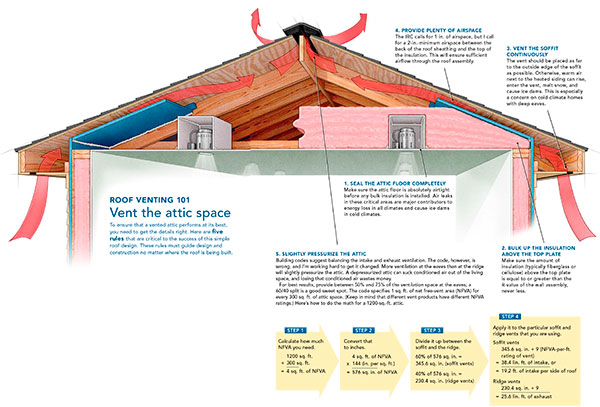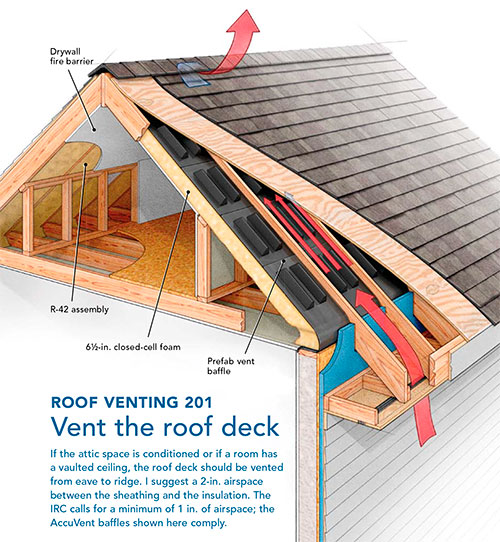Understand when to vent your roof and when not to, and how to execute each approach successfully. Reprinted with permission from Fine Homebuilding, Aug/Sept 2011, pages 68-72.
So much information has been devoted to the subject of roof venting that it's easy to become confused and to lose focus. So I'll start by saying something that might sound controversial, but really isn't: A vented attic, where insulation is placed on an air-sealed attic floor, is one of the most underappreciated building assemblies that we have in the history of building science. It's hard to screw up this approach. A vented attic works in hot climates, mixed climates, and cold climates. It works in the Arctic and in the Amazon. It works absolutely everywhere—when executed properly.
Unfortunately, we manage to screw it up again and again, and a poorly constructed attic or roof assembly can lead to excessive energy losses, ice dams, mold, rot, and lots of unnecessary homeowner angst.
Here, I'll explain how to construct a vented attic properly. I'll also explain when it makes sense to move the thermal, moisture, and air-control layers to the roof plane, and how to detail vented and unvented roofs correctly.
Theory behind venting
The intent of roof venting varies depending on climate, but it is the same if you're venting the entire attic or if you’re venting only the roof deck. In a cold climate, the primary purpose of ventilation is to maintain a cold roof temperature to avoid ice dams created by melting snow and to vent any moisture that moves from the conditioned living space to the attic. (See “Energy Smart Details” in FHB #218 for more on ice dams.)
In a hot climate, the primary purpose of ventilation is to expel solar-heated hot air from the attic or roof to reduce the building’s cooling load and to relieve the strain on air-conditioning systems. In mixed climates, ventilation serves either role, depending on the season.

Vent the attic
A key benefit of venting the attic is that the approach is the same regardless of how creative your architect got with the roof. Because the roof isn’t in play here, it doesn’t matter how many hips, valleys, dormers, or gables there are. It’s also easier and often less expensive to pile on fiberglass or cellulose insulation at the attic floor to hit target R-values than it is to achieve a comparable R-value in the roof plane.
The success of this approach hinges on the ceiling of the top level of the house being absolutely airtight before any insulation is installed. (See “Attic-Insulation Upgrade” in FHB #200.) It’s also important to ensure that there isn’t anything in the attic except lots of insulation and air—not the Christmas decorations, not the tuxedo you wore on your wedding day, nothing. Attic space can be used for storage, but only if you build an elevated platform above the insulation. Otherwise, the insulation gets compressed or kicked around, which diminishes its R-value. Also, attic-access hatches are notoriously leaky. You can build an airtight entry to the attic, but you should know that the more it is used, the leakier it gets.
How do people get this simple approach wrong? They don’t follow the rules. They punch a bunch of holes in the ceiling, they fill the holes with recessed lights that leak air, and they stuff mechanical systems with air handlers and a serpentine array of ductwork in the attic. The air leakage from these holes and systems is a major cause of ice dams in cold climates and a major cause of humidity problems in hot climates. It’s also an unbelievable energy waste no matter where you live.
Don’t think you can get away with putting ductwork in an unconditioned attic just because you sealed and insulated it. Ductsealing is faith-based work. You can only hope you’re doing a good-enough job. Even when you’re really diligent about airsealing, you can take a system with 20% leakage and bring it down to maybe 5% leakage, and that’s still not good enough.
With regard to recessed lights and other ceiling penetrations, it would be great if we could rely on the builder to air-seal all these areas. Unfortunately, we can’t be sure the builder will air-seal well or even air-seal at all. So we have to take some of the responsibility out of the builder’s hands and think of other options.
In a situation where mechanical systems or ductwork has to be in the attic space or when there are lots of penetrations in the ceiling below the attic, it’s best to bring the entire attic area inside the thermal envelope. This way, it’s not as big a deal if the ceiling leaks air or if the ducts are leaky and uninsulated.
Vent the roof deck
If the attic space is going to be conditioned, either for living or mechanical purposes, or if a home design calls for a vaulted ceiling, provision R806.3 in the International Residential Code calls for the roof deck above the space to be vented continuously from the eave to the ridge. This is easy to accomplish in simply constructed roofs and difficult, if not impossible, to accomplish in roofs that have hips, valleys, dormers, or skylights that interrupt the rafter bays.
If you choose to vent the roof deck, then be serious about it and really vent it. The code calls for a minimum of 1 in. of airspace between the top of the insulation and the back of the roof sheathing. That’s not enough. For best performance, the airspace in the vent chute should be a minimum of 2 in. deep. Unless you’re bulk-filling rafter bays between 2x10 or 2x8 rafters with closed-cell spray foam, this approach will likely require you to fur out the rafters to accommodate additional insulation to achieve desired R-values. That can be a pain, but you won’t run into the problems associated with having too little air circulating under the roof. To be sure your roof is getting enough ventilation, there are simple calculations that you can follow (sidebar p. 69)

Beyond the decreased capacity for insulation when venting the roof deck, venting the roof deck or the attic has some other drawbacks worth considering. In cold climates, snow can enter the soffit and ridge vents, melt, and potentially cause rot. Similarly, in coastal environments or in regions with lots of rain and wind, moisture can be forced into the vents and into the roof assembly. In hurricane-prone zones with frequent high-wind events, vented-soffit collapse can pressurize a building, which can cause windows to blow out and the roof to be blown off. Finally, in wildfire zones, floating embers can enter the vents and cause roof fires. If any of these . . .
Download complete document here.
